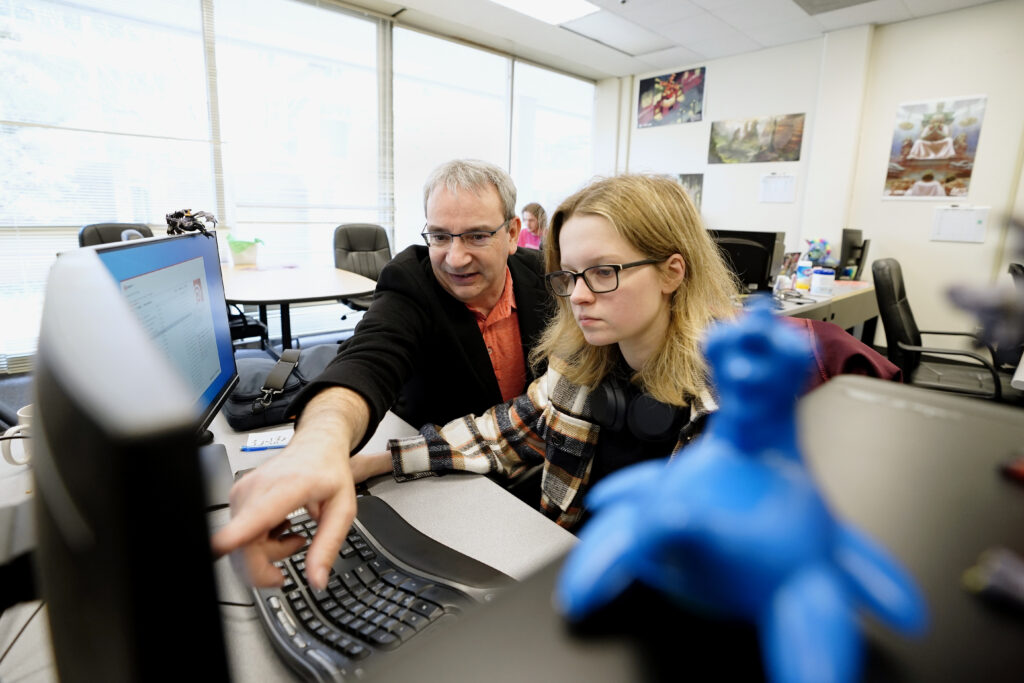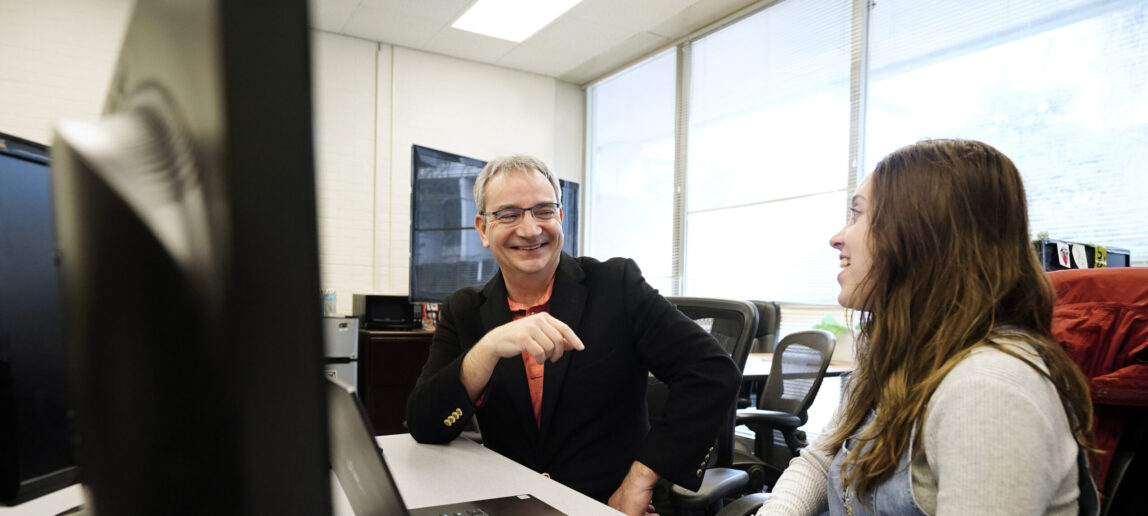LIVE Lab Explores New Horizons In Game-Based Education
Looking at the beautifully rendered sci-fi landscape of “Variant: Limits” — with its high cliffs, colorful plant life and intricately designed buildings — it’s hard to believe this game was created to teach calculus.
For the team members at Texas A&M University’s LIVE Lab, that impression means they’ve done their job right.
Short for Learning Interactive Visualization Experience Lab, the student-staffed studio prides itself on its innovative approach to educational video game design, combining the artistic quality and fun factor of an entertainment product with the academic rigor of a college course. In the case of “Variant,” players explore a distant alien world, solving a variety of calculus-based puzzles to progress through each level and save the planet from impending catastrophe.
“We knew some students didn’t learn very well just listening to a lecture, so we wanted to help students with a more interactive and fun way to learn calculus and help increase the amount of students passing calculus at college,” said LIVE Lab project manager and visualization senior Gabby Fisher.
The results speak for themselves, said the lab’s founder and director André Thomas, an associate professor of the practice of game design in A&M’s College of Performance, Visualization and Fine Arts. Thomas came to Aggieland in 2014 after a decades-long career in the movie and video game industries, lending his talents to such projects as “Men in Black” and EA Sports’ “Madden NFL” series.
Since then, he’s turned his focus to the creation of high-quality educational video games and other interactive experiences, finding plenty of help from students in A&M’s award-winning visualization program.
“Back when I worked at EA, I would hire a lot of Aggies to be interns and employees,” Thomas said. “I always say you can never do better than to hire an Aggie, because they’re good problem solvers, good communicators and good leaders.”
For those with the motivation to join Thomas and his team, the lab can provide a career head start, giving students a chance to make money working in a professional studio setting while honing their craft on a variety of games and other projects — all before they ever receive their degree.
“André really wants to push us and keep us at the front of what’s going on in technology, and give us the experience of working with other students as if we were already in the industry,” Fisher said. “Being here really gives me that hands-on experience to know what it’s going to be like when I do enter the workforce.”
Inside The Lab
Through the glass door marked “LIVE Lab” in a corner of the Langford Architecture Center’s Building C, visitors may notice the rows of computers and screens, many of them decorated with stickers, toys and other touches of personality that give the space a more lived-in look than the building’s other computer labs.
Inside, the group of artists, animators, programmers and designers that call this space home can be found working in concert, pausing every so often to exchange an equal mix of ideas, jokes and constructive feedback. The atmosphere is communal and lively, but productive at the same time. That’s exactly the way they like it, says Fisher.
“The best part about the work environment is the people,” she said. “The people that work here are really awesome, nice, collaborative people that are here to get work done but to have a good time too.”
Many of the team members were drawn to the LIVE Lab by a longtime love of video games, and most have ambitions of working in the games industry or a related field when they graduate, said Jocylin Lopez, the lab’s marketing lead.
The LIVE Lab was the birthplace of A&M’s world-record-holding game jam competition, Chillennium, and many of its student employees continue to play a key role in hosting the event each year, forging connections with industry sponsors and representatives in the process.
“I want to get into the games industry as an artist or someone who manages artists, and I definitely think those connections will help me learn how to get into the industry,” Lopez said. “So you get the experience for your resume, but you also get to meet a lot of people.”
The lab’s own original games — distributed by the Thomas-led publishing company Triseum — have found considerable success in high school and college classrooms around the world.
In addition to “Variant,” whose novel approach to math education caught the attention of major video game news outlets in the late 2010s, the lab is also responsible for the ongoing “ARTé” franchise — a series of games allowing players to experience different eras of art history while learning more about famous works of art and the societies that produced them.
“Instead of sitting through those art history lectures where you see painting after painting with fact after fact about who made it in what year, you get to go in and experience what it was like to be an artist or to buy and sell art during different time periods throughout history,” Fisher said.
Ultimately, Thomas said, the goal is to push the boundaries of what audiences have come to expect from educational games, creating experiences specifically tailored for older, more discerning students.
“There are lots of educational games out there for younger learners but not so many for older students, because the content is much more complicated and the expectations of the players are also significantly higher,” Thomas said. “So we wanted to see if we could create a high production value game, similar to something like EA would put out, with the budget and the time we have.”
The team brings that same level of attention to other pursuits, Fisher said. The lab accepts projects from a variety of outside clients, generating funds for future game projects and allowing students to apply their creative skills to a diverse array of digital tools and experiences.
These have ranged from artistic and imaginative — like the animated short film highlighting the work of a central Texas child therapy center — to highly technical and precise, like creating a detailed digital replica of an oil rig that inspectors can use to identify potential safety hazards and parts that need replacing.
“We’re lucky to work with students that are able to create these intricate 3D tools,” Fisher said. “They’ll go out and take photos of an environment and create a digital representation of that exact thing. It’s useful for situations where people aren’t able to go out and see the place in person, but they need to view it — we’re the people who can make that.”
One of the lab’s current projects originated during the height of the COVID-19 pandemic, but has since grown into something much larger. Once complete, it will help share one of Texas A&M’s signature programs with the rest of the world.

Virtual Disaster Day
For more than a decade, Texas A&M’s annual Disaster Day program has given aspiring nurses, doctors and other health profession students a chance to test their skills in a realistic disaster simulation.
Aggies have simulated hurricanes, industrial accidents and other disasters both natural and man-made, treating dozens of volunteer “patients” complete with movie-makeup wounds. But in 2021, when the event was canceled due to the real-life disaster caused by COVID-19, organizers turned to the LIVE Lab for help.
“When the pandemic hit, they weren’t able to do it in person anymore, so with about two months left, they came to us and said, ‘How can we make this virtual so that people can still experience it without being exposed?’” Fisher said.
That year’s virtual Disaster Day featured a slightly more off-the-wall scenario conveyed through video clips, as LIVE Lab students created an animated simulation of a meteor strike in Downtown Bryan and brought in a local news anchor to provide details on the unfolding disaster through scripted “breaking news” segments.
The clips helped spice up what could have been a dry virtual exercise, but the students at the LIVE Lab knew they could do even more if they had the time and resources. Since then, the lab has been working with postdoctoral researcher Dr. Michael Rugh and his team of undergraduate researchers to create a more extensive online Disaster Day simulation, constructing a virtual version of the simulation and a host of virtual victims in need of treatment.
Rugh said he and his team are trying to make the experience as true to life as possible, while focusing largely on “communication and collaboration for the betterment of patients.” The project has involved extensive research in the areas of interprofessional collaboration, nursing, medicine, public health, pharmacy, dentistry and emergency response.
“What we’re looking for is immersion,” Rugh said. “I have learned a surprising amount of medical knowledge that I never thought I’d have to learn,” from the basic principles of triage to advanced surgical procedures.
It won’t be a substitute for the live Disaster Day event, but ultimately it’s not meant to be. Rugh said the main value of a virtual tool like this is that it can one day be used at other universities and institutions around the nation, many of which don’t have the funding or the volunteers to stage a large-scale disaster simulation with live actors.
“There are lots of universities that don’t have the resources that Texas A&M does, so I think our game can really help out there,” Rugh said. “We can provide access to high-quality health care training for professionals and students across the country, semester after semester, without needing to retrain live actors.”
For the team at the LIVE Lab, the project represents another chance to keep pushing the boundaries of virtual education — all while building crucial skills that the students will use in their future careers.
“Every student that leaves us, it’s always a sad moment, but it’s also a joyful moment,” Thomas said. “So far, we have a 100% success rate of students coming from the lab and getting a job in their field of study. It’s really great to see all of them being successful because it tells us that ‘Yes, we are doing something right here.’”
Top photo: André Thomas and Gabby Fisher at the LIVE Lab. Photo by Laura McKenzie/Texas A&M University Division of Marketing and Communications.

